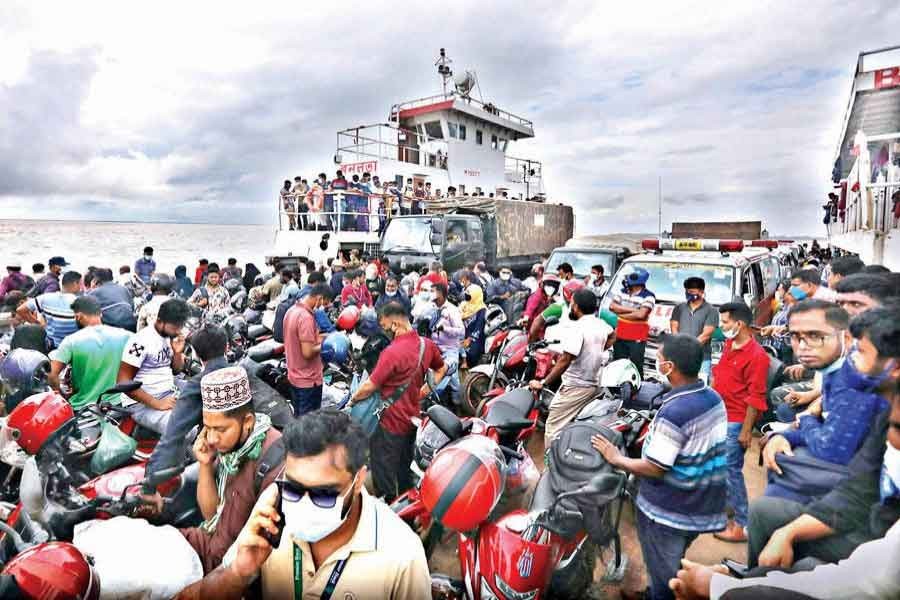During the recent corona-prompted lockdown, a distressing aspect of the domestic or internal migration could be seen in a nearly full-length form. Normally, the internal migration in the times of peace follows the rural-to-urban trend. People, mostly victims of poverty, lack of income andbankable employment, and the repeated assaults of natural disasters, set out for cities individually as well as in groups. In the 21st century Bangladesh, with its socio-economic matrix getting firmer than ever before, the domestic migration had trickled down to a thin flow. Thanks to the availability of urban facilities in villages, the rural people find little logic in setting out for the capital and the large cities. In the process, the rural-to-urban exodus veritably ground to a halt.
With the Covid-19 pandemic lockdown in force for a months-long stretch beginning March-end, a reverse trend of domestic migration became manifest. Being mostly Covid-19-centred, the developments demonstrated a completely new look. Instead of the rush towards cities, the new exodus was directed towards the rural areas of the country. Apart from the fear of being attacked by the corona virus, they started viewing Dhaka as hostile in terms of affordable living. People ranging from those belonging to the lower- and lower-middle classes to those in the traditional middle class category joined the march towards their village homes. Mostly small traders and entrepreneurs, and also private job holders, these people vowed never to return to the 'cruel' cities. Few had pondered the two harsh realities that awaited them back in their sweet old villages. Nor did they care for the situational changes which normally accompanied pandemic-hit regions.
With the arrival of vaccines, and vaccination campaigns going on in full swing, the rural swathes of the country proved, in no time, a place safer than the cities. To add to these developments, the villages previously averse to corona vaccines calling them an 'urban issue' became desperate to get vaccinated. Earlier, isolated cases of Covid-19 would be detected in the country's rural areas. Since the village-bound migrants had veritably left the urban areas by uprooting their ties to the city life, they were now presumably stuck up in their rural confines. There should have been warnings from the authorities saying that a pandemic doesn't make assaults on a land to dig their heels in there. They knew that the Covid-19 situation was set to improve, and several types of vaccines would soon be destined to Bangladesh. They didn't feel it necessary to keep the people fleeing Dhaka abreast of it. Unaware of the facts, the migrants from cities settled down in the villages, and pondered the ways of beginning life anew.
The harsh reality which has started taking root in the vast rural areas of Bangladesh lately is distressing. According to health authorities, the corona outbreak is fast spreading across the villages and the outlying areas. Apart from the mismanagement in administering vaccines leading to non-availability of jabs in areas, a piece of news spread in villages has turned out to be a feared source of trouble. The news item says, of the total rural cases, around 90pc of them have been infected by people coming from the cities during the lockdown. Without mincing words, a study published recently in the UK-based journal Nature Microbiology says the mass migration of people from Dhaka and its suburbs last year is the prime reason for the countrywide spread of Covid-19. In fact, it was common knowledge that things would deteriorate in a short time. Another troubling aspect of the episode is the feeling of anxieties the urban migrants are set to go through when many of them will remain deprived of the vaccines. As bona fideinhabitants of villages, the rural residents are expected to assert quite vocally their right to get vaccinated first. Meanwhile, repeated government announcements continue to tell the public that hundreds and thousands of Covid-19 jabs are on way to Bangladesh. Apart from it, new phases of mass vaccination are said to be resuming soon in the rural areas upon arrival of the vaccines. Unfortunately, the migrants from the cities are feared to be deprived of the jabs. The reason for their possible missing out on the inoculations is their urban identity.
For a couple of decades, Bangladesh has been free of domestic migrations. With socio-economic development indices being on an upward trajectory, the city-ward exodus of rural people has witnessed remarkable decline. Except on occasions of short-lived rural socio-economic turmoil caused by rare phases of crop failure, the trend of rural migration had veritably been seen on the wane. There was no incidence of deadly pandemics in the recent memory in villages and remote areas, which could have triggered a city-bound shifting. However, the memories of the Great Bengal Famine in 1770 and that of 1943 caused by crop failures, epidemics and the administrative failures of the British rulers are etched out in the Bengal history as dark chapters.
It was during these two catastrophic events of food scarcity throughout Bengal, when caravans of starving people were seen desperately rushing for the cities --- all in search of food. In Dhaka and Kolkata, the skeletal humans were found lying half-dead beside dustbins.It's worth noting that unlike in the African continent, the Bengal region didn't ever have to flee to safe zones on being hounded by climate extremities. However, a mass dislocation of people unfolded after a brutal genocide was let loose on East Bengal by the Pakistan Occupation Army in 1971. It was during this period Bangladesh witnessed its first-ever great exodus to villages. Although not occurring on a mass scale, the corona-prompted village-bound migration deserves to be recorded in Bangladesh history. It's not as much for people fleeing a pandemic, as it is for some cold truths of the 'new reality'.


